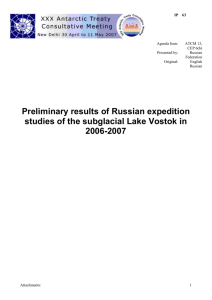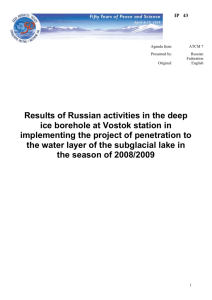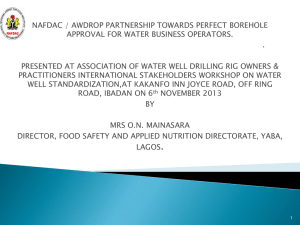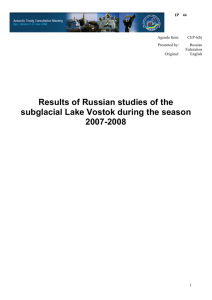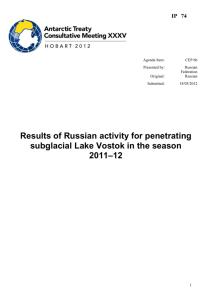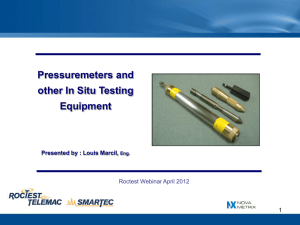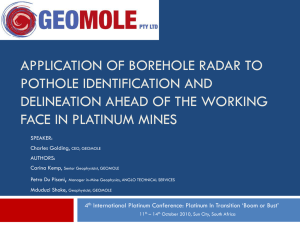2009-10 report presented at the May 2010 ATCM - Amundsen
advertisement
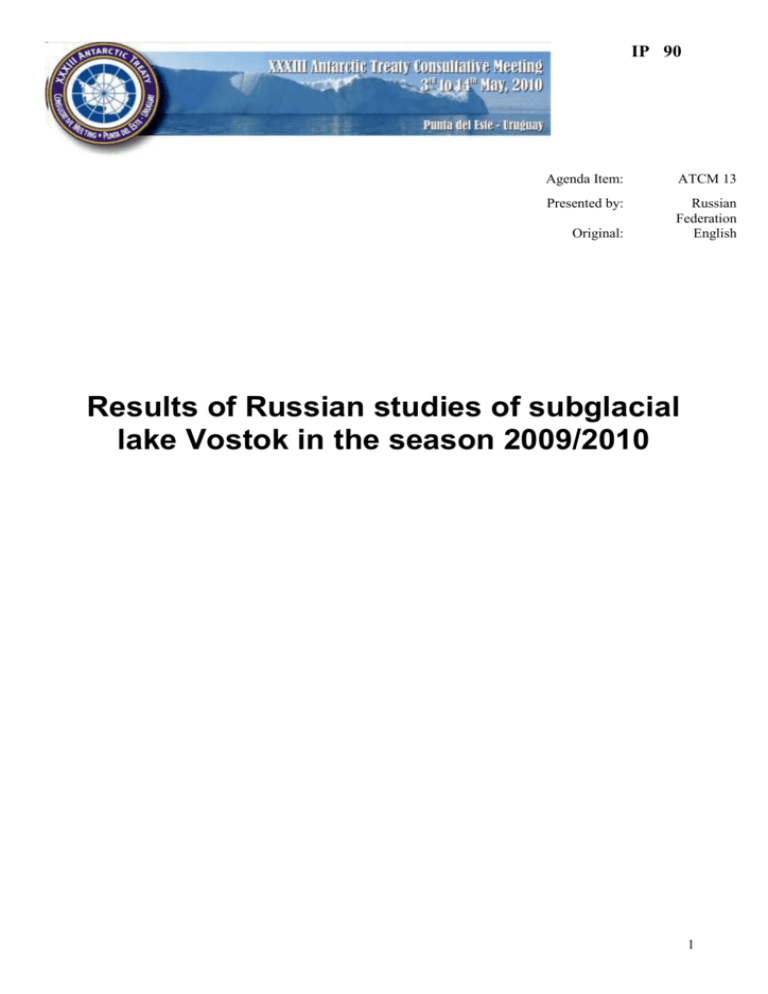
IP 90 Agenda Item: ATCM 13 Presented by: Russian Federation English Original: Results of Russian studies of subglacial lake Vostok in the season 2009/2010 1 IP 90 Results of Russian studies of subglacial lake Vostok in the season 2009/2010 The main aim of glaciological-drilling activities at Vostok station in the season 2009-2010 was to complete the process of deflection of the faulty borehole and resume drilling in the new borehole 5G-2. All attempts undertaken in the season 2008-2009 to recover the drill stuck at the bottom of borehole 5G-1 (at a depth of 3667 m) due to narrowing of its diameter have failed. In the end of January 2009, deflection of this ice borehole was started beginning from the 3590 m horizon, in order to bypass the segment with the damaged drill. The deflection technology was developed at the St. Petersburg Mining Institute and successfully applied on 5 September 1992 in borehole 5G at a depth of 2243 m. This deflection depth of the new borehole in January 2009 was chosen in order to obtain an additional ice core with a large concentration of mineral inclusions, detected earlier in borehole 5G-1 between the 3604-3610 m horizons. After bringing drilling equipment back into operation and its adjustment the caliper measurements of the borehole and drilling fluid density measurements at different depths were carried out. After correction of the drilling fluid density, the borehole diameter was calibrated by drilling out the segments where a decrease of the diameter was registered. Preparatory work showed the near-bottom area of the new borehole 5G-2 (a depth of 3598 m) to be filled with the ice sludge saturated with ethylene glycol, used in the attempt to extract the drill from borehole 5G-1. After cleaning the new borehole from sludge, it was decided to increase the deflection angle of borehole 5G-2 from vertical to 1.5 deg. This operation made it possible to prevent ethylene glycol from getting into the new borehole and on 7 January 2010, drilling of borehole 5G-2 began with ice core extraction. Drilling operations were carried out on a 24-hour basis. To intensify the drilling process, the bore bit cutters grinded in a special way were used, allowing a three-fold increase of the cut ice layer thickness and retrieval of 1.5 m of the new ice core during one drill run. As a result of drilling operations in the season 2009-2010, the depth of borehole 5G-2 at Vostok station is 3650 m. During wintering-over in 2010 it is planned to replace the winch drilling cable and thus to complete drilling up to the water layer of Lake Vostok for two-three weeks of work in the season of 2009-11. Petrostructural studies of the ice core from borehole 5G-2, carried out directly at Vostok station, have revealed significant differences in the structure and texture of two parallel lake ice cores recovered from boreholes 5G-1 and 5G-2. The ice structure in the core from borehole 5G-2 is finer-grained and is characterized by evident indications of ice deformation that were never observed before in the 5G-1 ice core. According to preliminary conclusions, this is connected with significant deformations of ice surrounding borehole 5G-1, which has experienced significant horizontal pressures in 2007. The zone within which one clearly observes structural modifications has in the section the shape of a ring around the borehole with a width of 30-50 cm. This conclusion can be supplemented by the results of investigating orientation of crystal c-axes. It should be assumed that after the depth of 3668 m the crystalline ice structure observed before in borehole 5G-1, will be preserved. The chosen horizon of the new borehole 5G-2 deflection from faulty 5G-1 (3590 m) was connected with a wish to obtain a new ice core with a significant concentration of mineral inclusions, noted in the core from borehole 5G-1 in the 3604-3609 m layer. The marking layer of large mineral inclusions earlier encountered in borehole 5G-1 at a depth of 360630-3606.50 m, was detected in core 5G-2 at a depth of 3607.00-3607.10 m. These results indicate an insignificant difference of the vertical location of this layer (70±5 cm) in two parallel boreholes, which however should be taken into account for drilling in borehole 5G-2. Of special interest is a new mineralized layer with microscopic inclusions located in depths of 3617.253617.32 m, detected in the core from 5G-2, which was not observed before in the core from borehole 5G-1. Additional studies of the archived collection of ice cores from borehole 5G-1, stored at Vostok station, allowed revealing this layer in depths of 3616.70 3617.26 and 3617.91. This finding has changed initial understanding of the vertical interface of two types of lake ice as before it was believed to be confined to the horizon of 3609 m. 3 IP 90 During the season 2009-10 seismic studies of the deep geological structure of the valley where the subglacial Lake Vostok is situated were carried out by the method of refracted waves with the aim to investigate its possible riftogenic origin. Eight soundings at different points located along the longitudinal lake axis were made for this purpose. Their results are being processed at present. Simultaneously, specialists from Russia and Germany continued GPS measurements of the drift direction and speed of “diurnal glacial surface” over the Lake Vostok area using landmarks set up in the season 2007-08. Data of these studies will help us to develop further existing understanding of the nature of origin of subglacial Lake Vostok. 4



